A panorama of disruptive and emergent digital technologies usages for training purposes: Methodology
Introduction
To conduct a panorama of the uses of disruptive and emergent technologies for training purposes, we examined the scientific and professional literature on the design, development, and implementation of research-informed or theory-based training programs involving emergent technologies as well as the development of technological solutions for training in higher education, health, banking, human resources, transportation, government, and private organizations.
Out of 1572 initially identified publications for the period between January 2019 and December 2019, 95 articles were included in the final synthesis based on explicit inclusion and exclusion criteria.
The following research questions guided the literature review:
- RQ1. What disruptive/emergent technologies do sectors such as health, banking, human resources, transportation, higher education, government, and private organizations use to train their people?
- RQ2. How do sectors such as health, banking, human resources, transportation, higher education, government, and private organizations use these emergent technologies to train their people?
Methodology
The purpose of this literature review was to identify the reported usages of disruptive and emerging technologies for training purposes in the following sectors: Higher education, health, banking, human resources, transportation, government, and private organizations. In order to do so, we followed the following steps:
- Define key concepts and search terms according to the purpose of the literature review, as per table 1.
- Perform a search in a series of scientific databases using search terms associated with three key concepts (i.e. domain, technology, and sector).
- Due to a large amount of retrieved unrelated papers in previous search strings and to the wide scope of the research that aims to gather information in several sectors, the Boolean/Phrase type of search was chosen since its search operators permit to narrow the search and provide more relevant results.
- The documents that were considered for the study include peer-reviewed articles, conceptual papers, reviews of literature and editorial articles in professional magazines published between January 2019 and December 2019.
- The search string and criteria for this literature review included publications indexed in EBSCO Host listed databases Academic Search Premier, Education Source, ERIC, and Human Resources Abstracts.
- Refine the search string. The final search strategy shown in Table 1 was refined by focusing on retrieving documents with the search terms associated with the technology key concept in the title.
- Select publications per title according to inclusion criteria. By refining the search with concept 2 in the title, duplicates were removed and publications were selected based on the inclusion criteria.
- Select publications per abstract information. After duplicates were removed, abstracts were considered to select papers based on the following inclusion criteria:
- Articles reported the use of disruptive/emerging technologies within the scope of training, learning, and development or professional development in the identified sectors.
- Full-text was available. If a paper was unavailable via database searches, requests were sent directly to the authors.
- Articles were written in English.
- Articles had been published in 2019.
- Select publications per full-text according to inclusion and exclusion criteria. Once the full-texts were retrieved, articles were selected or excluded according to the previously mentioned inclusion criteria. Excluded articles at this phase presented one of the following characteristics:
- Articles focused on elementary or high school rather than training and/or higher education.
- Articles did not report the use of emergent technologies for training.
- Articles reported the use of emergent or disruptive technologies for other uses rather than training.
- Full-texts were not written in English.
- Full-text was unavailable.
- Review publications for inclusion in the research report. Selected papers were retrieved from a search undertaken in late October 2019. The publication screening process is summarized in Table 2 and Figure 1.
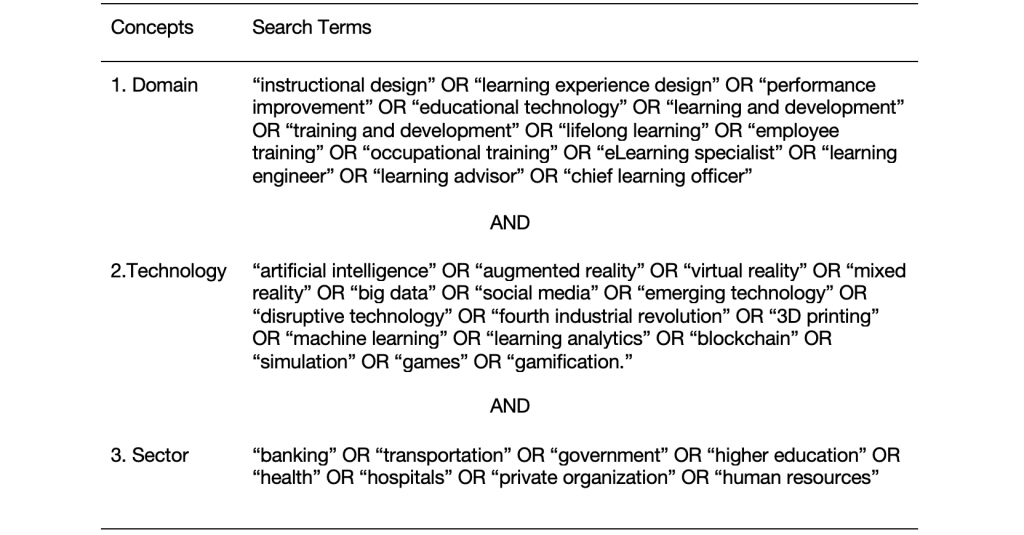
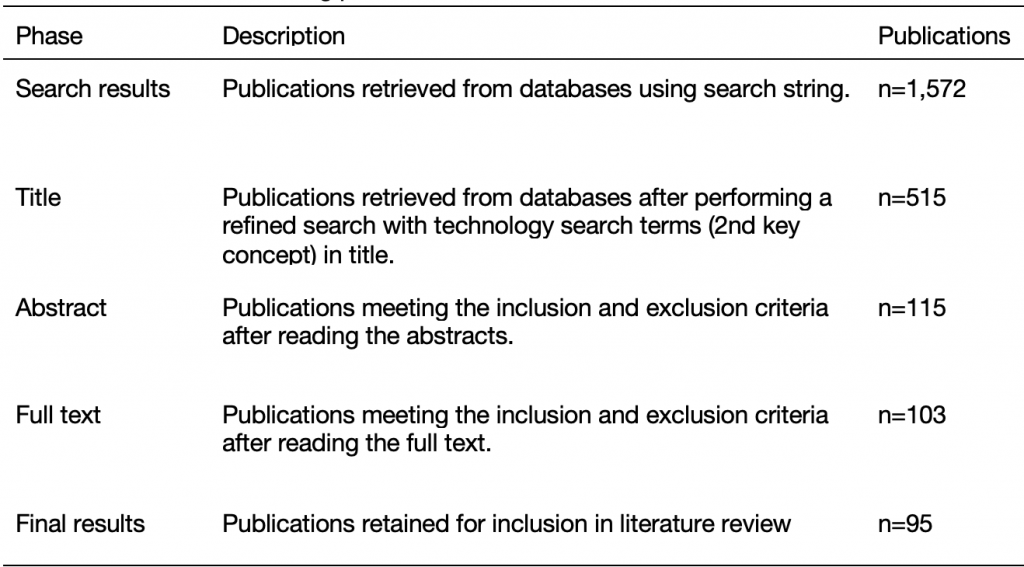
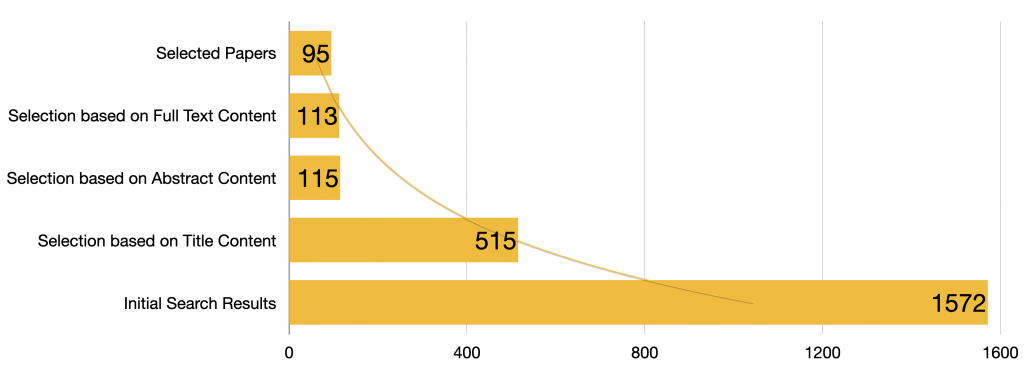
To note, since the final draft of this report, 5 more full-text articles were sent to us by the authors. These articles were not included in the results section but are included in the references list.
Results
This literature review aimed to examine the scientific and professional literature on emergent technology use for training in higher education, health, banking, human resources, transportation, government, and private organizations. Table 3 presents the panorama of emerging technologies used for training per sector.
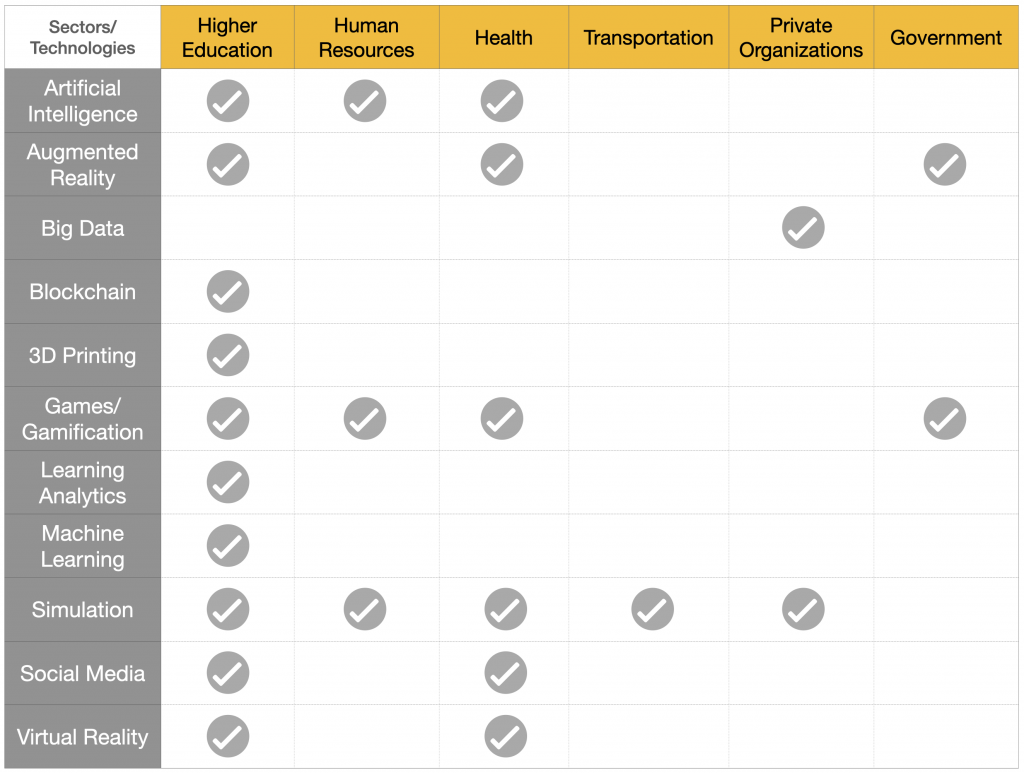
References
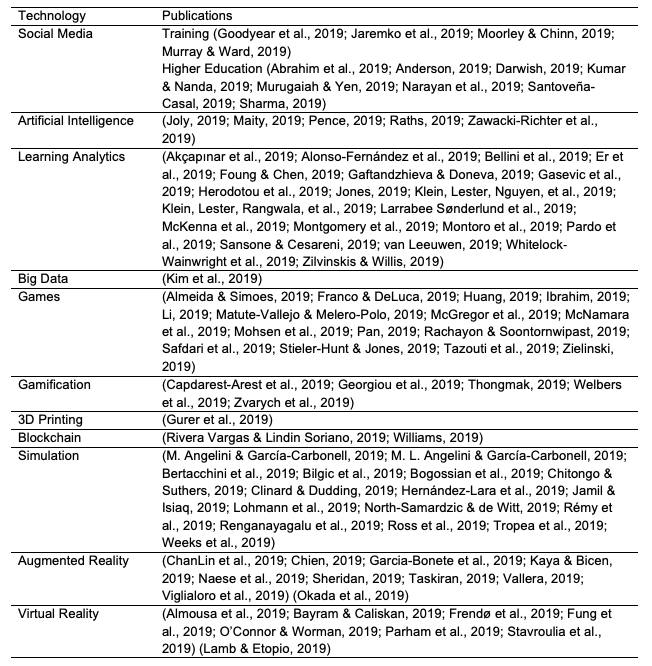
- Abrahim, S., Mir, B. A., Suhara, H., Mohamed, F. A., & Sato, M. (2019). Structural equation modeling and confirmatory factor analysis of social media use and education. International Journal of Educational Technology in Higher Education, 16(1), 32. https://doi.org/10.1186/s41239-019-0157-y
- Akçapınar, G., Altun, A., & Aşkar, P. (2019). Using learning analytics to develop early-warning system for at-risk students. International Journal of Educational Technology in Higher Education, 16(1), 40. https://doi.org/10.1186/s41239-019-0172-z
- Almeida, F., & Simoes, J. (2019). The Role of Serious Games, Gamification and Industry 4.0 Tools in the Education 4.0 Paradigm. Contemporary Educational Technology, 120–136. https://doi.org/10.30935/cet.554469
- Almousa, O., Prates, J., Yeslam, N., MacGregor, D., Zhang, J., Phan, V., Nielsen, M., Smith, R., & Qayumi, K. (2019). Virtual Reality Simulation Technology for Cardiopulmonary Resuscitation Training: An Innovative Hybrid System With Haptic Feedback. Simulation & Gaming, 50(1), 6–22. https://doi.org/10.1177/1046878118820905
- Alonso-Fernández, C., Cano, A. R., Calvo-Morata, A., Freire, M., Martínez-Ortiz, I., & Fernández-Manjón, B. (2019). Lessons learned applying learning analytics to assess serious games. Computers in Human Behavior, 99, 301–309. https://doi.org/10.1016/j.chb.2019.05.036
- Anderson, T. (2019). Challenges and Opportunities for Use of Social Media in Higher Education. Journal of Learning for Development, 6(1), 6–19.
- Angelini, M., & García-Carbonell, A. (2019). Enhancing students’ written production in English through flipped lessons and simulations. International Journal of Educational Technology in Higher Education, 16(1), 2. https://doi.org/10.1186/s41239-019-0131-8
- Angelini, M. L., & García-Carbonell, A. (2019). Developing English Speaking Skills Through Simulation-based Instruction. Teaching English with Technology, 19(2), 3–20.
- Bavelier, D., & Green, C. S. (2019). Enhancing Attentional Control: Lessons from Action Video Games. Neuron, 104(1), 147–163. https://doi.org/10.1016/j.neuron.2019.09.031
- Bayram, S. B., & Caliskan, N. (2019). Effect of a game-based virtual reality phone application on tracheostomy care education for nursing students: A randomized controlled trial. Nurse Education Today, 79, 25–31. https://doi.org/10.1016/j.nedt.2019.05.010
- Bellini, C., De Santis, A., Sannicandro, K., & Miverva, T. (2019). Data Management in Learning Analytics: Terms and Perspectives. Journal of E-Learning & Knowledge Society, 15(3), 133–144.
- Bertacchini, F., Bilotta, E., Caldarola, F., & Pantano, P. (2019). The role of computer simulations in learning analytic mechanics towards chaos theory: A course experimentation. International Journal of Mathematical Education in Science and Technology, 50(1), 100–120. https://doi.org/10.1080/0020739X.2018.1478134
- Bilgic, E., Alyafi, M., Hada, T., Landry, T., Fried, G. M., & Vassiliou, M. C. (2019). Simulation platforms to assess laparoscopic suturing skills: A scoping review. Surgical Endoscopy, 33(9), 2742–2762. https://doi.org/10.1007/s00464-019-06821-y
- Bogossian, F. E., Cant, R. P., Ballard, E. L., Cooper, S. J., Levett‐Jones, T. L., McKenna, L. G., Ng, L. C., & Seaton, P. C. (2019). Locating “gold standard” evidence for simulation as a substitute for clinical practice in prelicensure health professional education: A systematic review. Journal of Clinical Nursing, 28(21–22), 3759–3775. https://doi.org/10.1111/jocn.14965
- Capdarest-Arest, N., Opuda, E., & Stark, R. K. (2019). “Game on!” Teaching gamification principles for library instruction to health sciences information professionals using interactive, low-tech activities and design-thinking modalities. Journal of the Medical Library Association, 107(4). https://doi.org/10.5195/jmla.2019.636
- ChanLin, L.-J., Chan, K.-C., & Wang, C.-R. (2019). An epistemological assessment of learning nutritional information with augmented reality. The Electronic Library, 37(2), 210–224. https://doi.org/10.1108/EL-06-2018-0128
- Chien, C. (2019). English for Ecotourism and Its Sustainability with Augmented Reality Technology. International Education Studies, 12(6), 134. https://doi.org/10.5539/ies.v12n6p134
- Chitongo, S., & Suthers, F. (2019). Use of technology in simulation training in midwifery. British Journal of Midwifery, 27(2), 85–89. https://doi.org/10.12968/bjom.2019.27.2.85
- Darwish, E. B. (2019). Social Media Education in the Arab World: Reality and Challenges. 17th International Conference on E-Society 2019, 21–28. https://doi.org/10.33965/es2019_201904L003
- Er, E., Gómez-Sánchez, E., Dimitriadis, Y., Bote-Lorenzo, M. L., Asensio-Pérez, J. I., & Álvarez-Álvarez, S. (2019). Aligning learning design and learning analytics through instructor involvement: A MOOC case study. Interactive Learning Environments, 27(5–6), 685–698. https://doi.org/10.1080/10494820.2019.1610455
- Foung, D., & Chen, J. (2019). A Learning Analytics Approach to the Evaluation of an Online Learning Package in a Hong Kong University. The Electronic Journal of E-Learning, 17(1), 11–24.
- Franco, P., & DeLuca, D. A. (2019). Learning Through Action: Creating and Implementing a Strategy Game to Foster Innovative Thinking in Higher Education. Simulation & Gaming, 50(1), 23–43. https://doi.org/10.1177/1046878118820892
- Frendø, M., Thingaard, E., Konge, L., Sørensen, M. S., & Andersen, S. A. W. (2019). Decentralized virtual reality mastoidectomy simulation training: A prospective, mixed-methods study. European Archives of Oto-Rhino-Laryngology, 276(10), 2783–2789. https://doi.org/10.1007/s00405-019-05572-9
- Fung, F. M., Choo, W. Y., Ardisara, A., Zimmermann, C. D., Watts, S., Koscielniak, T., Blanc, E., Coumoul, X., & Dumke, R. (2019). Applying a Virtual Reality Platform in Environmental Chemistry Education To Conduct a Field Trip to an Overseas Site. Journal of Chemical Education, 96(2), 382–386. https://doi.org/10.1021/acs.jchemed.8b00728
- Gaftandzhieva, S., & Doneva, R. (2019). Toward a Learning Analytics System in Bulgarian Higher Education Institutions. TEM Journal, 8(3), 1058–1062. https://doi.org/10.18421/TEM83-51
- Garcia-Bonete, M.-J., Jensen, M., & Katona, G. (2019). A practical guide to developing virtual and augmented reality exercises for teaching structural biology: VR and AR for Teaching Structural Biology. Biochemistry and Molecular Biology Education, 47(1), 16–24. https://doi.org/10.1002/bmb.21188
- Gasevic, D., Tsai, Y.-S., Dawson, S., & Pardo, A. (2019). How do we start? An approach to learning analytics adoption in higher education. The International Journal of Information and Learning Technology, 36(4), 342–353. https://doi.org/10.1108/IJILT-02-2019-0024
- Georgiou, K., Gouras, A., & Nikolaou, I. (2019). Gamification in employee selection: The development of a gamified assessment. International Journal of Selection and Assessment, 27(2), 91–103. https://doi.org/10.1111/ijsa.12240
- Goodyear, V. A., Parker, M., & Casey, A. (2019). Social media and teacher professional learning communities. Physical Education and Sport Pedagogy, 24(5), 421–433. https://doi.org/10.1080/17408989.2019.1617263
- Gorham, T., Jubaed, S., Sanyal, T., & Starr, E. (2019). Assessing the Efficacy of VR for Foreign Language Learning Using Multimodal Learning Analytics. In C. N. Giannikas, E. Kakoulli Constantinou, & S. Papadima Sophocleus (Eds.), Professional development in CALL: a selection of papers (pp. 101–116). https://books.google.ca/books?hl=en&lr=&id=kiKNDwAAQBAJ&oi=fnd&pg=PA101&dq=%22Assessing+the+Efficacy+of+VR+for+Foreign+Language+Learning+Using+Multimodal+Learning+Analytics%22&ots=rVi8d1QeeL&sig=u_gYnjPgqqu2oFt8pI7rnydQS34&redir_esc=y#v=onepage&q=%22Assessing%20the%20Efficacy%20of%20VR%20for%20Foreign%20Language%20Learning%20Using%20Multimodal%20Learning%20Analytics%22&f=false
- Gurer, M. D., Tekinarslan, E., Kocaayak, I., & Gonultas, S. (2019). Development and validation of an attitude assessment scale for the use of 3D printing in education. International Journal of Education and Development Using Information and Communication Technology (IJEDICT), 15(1), 190–203.
- Hernández-Lara, A. B., Serradell-López, E., & Fitó-Bertran, À. (2019). Students’ perception of the impact of competences on learning: An analysis with business simulations. Computers in Human Behavior, 101, 311–319. https://doi.org/10.1016/j.chb.2019.07.023
- Herodotou, C., Rienties, B., Boroowa, A., Zdrahal, Z., & Hlosta, M. (2019). A large-scale implementation of predictive learning analytics in higher education: The teachers’ role and perspective. Educational Technology Research and Development, 67(5), 1273–1306. https://doi.org/10.1007/s11423-019-09685-0
- Horowitz, K. S. (2019). Video Games and English as a Second Language: The Effect of Massive Multiplayer Online Video Games on The Willingness to Communicate and Communicative Anxiety of College Students in Puerto Rico. American Journal of Play, 11(3), 379–410.
- Huang, Y.-M. (2019). Exploring students’ acceptance of educational computer games from the perspective of learning strategy. Australasian Journal of Educational Technology, 35(3), 132–149.
- İbili, E. (2019). Effect of augmented reality environments on cognitive load: Pedagogical effect, instructional design, motivation and interaction interfaces. International Journal of Progressive Education, 15(5), 42–57. https://doi.org/10.29329/ijpe.2019.212.4
- Ibrahim, K. (2019). Foreign language practice in simulation video games: An analysis of game‐based FL use dynamics. Foreign Language Annals, 52(2), 335–357. https://doi.org/10.1111/flan.12388
- Jamil, M. G., & Isiaq, S. O. (2019). Teaching technology with technology: Approaches to bridging learning and teaching gaps in simulation-based programming education. International Journal of Educational Technology in Higher Education, 16(1), 25. https://doi.org/10.1186/s41239-019-0159-9
- Jaremko, K. M., Schwenk, E. S., Pearson, A. C. S., Hagedorn, J., Udani, A. D., Schwartz, G., Elkassabany, N. M., Snively, A., & Mariano, E. R. (2019). Teaching an old pain medicine society new tweets: Integrating social media into continuing medical education. Korean Journal of Anesthesiology, 72(5), 409–412. https://doi.org/10.4097/kja.19261
- Joly, K. (2019). Digital marketing trends for 2019: Privacy concerns, artificial intelligence and shifts in social media lie ahead. University Business, 22(1), 46–46.
- Jones, K. M. L. (2019). Learning analytics and higher education: A proposed model for establishing informed consent mechanisms to promote student privacy and autonomy. International Journal of Educational Technology in Higher Education, 16(1), 24. https://doi.org/10.1186/s41239-019-0155-0
- Kaya, O. S., & Bicen, H. (2019). Study of Augmented Reality Applications Use in Education and Its Effect on the Academic Performance: International Journal of Distance Education Technologies, 17(3), 25–36. https://doi.org/10.4018/IJDET.2019070102
- Kim, A. S. N., Wong-Kee-You, A. M. B., Wiseheart, M., & Rosenbaum, R. S. (2019). The spacing effect stands up to big data. Behavior Research Methods, 51(4), 1485–1497. https://doi.org/10.3758/s13428-018-1184-7
- Klein, C., Lester, J., Nguyen, T., Justen, A., Rangwala, H., & Johri, A. (2019). Student Sensemaking of Learning Analytics Dashboard Interventions in Higher Education. Journal of Educational Technology Systems, 48(1), 130–154. https://doi.org/10.1177/0047239519859854
- Klein, C., Lester, J., Rangwala, H., & Johri, A. (2019). Learning Analytics Tools in Higher Education: Adoption at the Intersection of Institutional Commitment and Individual Action. The Review of Higher Education, 42(2), 565–593. https://doi.org/10.1353/rhe.2019.0007
- Kumar, V., & Nanda, P. (2019). Social Media in Higher Education: A Framework for Continuous Engagement. International Journal of Information and Communication Technology Education, 15(1), 109–120.
- Lamb, R. L., & Etopio, E. (2019). Virtual Reality Simulations and Writing: A Neuroimaging Study in Science Education. Journal of Science Education and Technology, 28(5), 542–552. https://doi.org/10.1007/s10956-019-09785-9
- Larrabee Sønderlund, A., Hughes, E., & Smith, J. (2019). The efficacy of learning analytics interventions in higher education: A systematic review. British Journal of Educational Technology, 50(5), 2594–2618. https://doi.org/10.1111/bjet.12720
- Lohmann, G., Pratt, M. A., Benckendorff, P., Strickland, P., Reynolds, P., & Whitelaw, P. A. (2019). Online business simulations: Authentic teamwork, learning outcomes, and satisfaction. Higher Education, 77(3), 455–472. https://doi.org/10.1007/s10734-018-0282-x
- Maity, S. (2019). Identifying opportunities for artificial intelligence in the evolution of training and development practices. Journal of Management Development, 38(8), 651–663. https://doi.org/10.1108/JMD-03-2019-0069
- Matute-Vallejo, J., & Melero-Polo, I. (2019). Understanding online business simulation games: The role of flow experience, perceived enjoyment and personal innovativeness. Australasian Journal of Educational Technology, 35(3). https://doi.org/10.14742/ajet.3862
- McGregor, K. K., Marshall, B. A., Julian, S. K., & Oleson, J. (2019). Learning While Playing: A Randomized Trial of Serious Games as a Tool for Word Mastery. Language, Speech, and Hearing Services in Schools, 50(4), 596–608. https://doi.org/10.1044/2019_LSHSS-VOIA-18-0121
- McKenna, K., Pouska, B., Moraes, M. C., & Folkestad, J. E. (2019). Visual-Form Learning Analytics: A Tool for Critical Reflection and Feedback. Contemporary Educational Technology, 10(3). https://doi.org/10.30935/cet.589989
- McNamara, J., Bent, M., & Grace, P. (2019). Using Applied Game and Simulation Technologies to Support Continued Practice Competency: A Case Study. Journal of Applied Testing Technology, 20(1), 59–77.
- Mohsen, K., Abdollahi, S., & Omar, S. (2019). Evaluating the educational value of simulation games: Learners’ perspective. Innovations in Education and Teaching International, 56(4), 517–528. https://doi.org/10.1080/14703297.2018.1515646
- Montgomery, A. P., Mousavi, A., Carbonaro, M., Hayward, D. V., & Dunn, W. (2019). Using learning analytics to explore self-regulated learning in flipped blended learning music teacher education: Learning analytics and teacher education. British Journal of Educational Technology, 50(1), 114–127. https://doi.org/10.1111/bjet.12590
- Montoro, M. A., Ortiz Colón, A. Ma., Rodríguez Moreno, J., & Steffens, K. (2019). Emerging technologies. Analysis and current perspectives. Digital Education Review, 35, 186–210. https://revistes.ub.edu/index.php/der/article/view/27395
- Moorley, C., & Chinn, T. (2019). Social media participatory CPD for nursing revalidation, professional development and beyond. British Journal of Nursing, 28(13), 870–877. https://doi.org/10.12968/bjon.2019.28.13.870
- Murray, K., & Ward, K. (2019). Attitudes to social media use as a platform for Continuing Professional Development (CPD) within occupational therapy. Journal of Further and Higher Education, 43(4), 545–559. https://doi.org/10.1080/0309877X.2017.1378313
- Murugaiah, P., & Yen, S. H. (2019). Implementing a Social Media-Based Curriculum for Newly-Matched Interns. International Journal of Virtual and Personal Learning Environments, 9(2), 4.
- Naese, J. A., McAteer, D., Hughes, K. D., Kelbon, C., Mugweru, A., & Grinias, J. P. (2019). Use of Augmented Reality in the Instruction of Analytical Instrumentation Design. Journal of Chemical Education, 96(3), 593–596. https://doi.org/10.1021/acs.jchemed.8b00794
- Narayan, V., Herrington, J., & Cochrane, T. (2019). Design principles for heutagogical learning: Implementing student-determined learning with mobile and social media tools. Australasian Journal of Educational Technology, 35(3), 86–101.
- North-Samardzic, A., & de Witt, M. (2019). Designing a Human Resource Management Simulation to Engage Students. Journal of Management Education, 43(4), 359–395. https://doi.org/10.1177/1052562919841411
- O’Connor, E. A., & Worman, T. (2019). Designing for Interactivity, While Scaffolding Student Entry, Within Immersive Virtual Reality Environments. Journal of Educational Technology Systems, 47(3), 292–317. https://doi.org/10.1177/0047239518817545
- Pan, Q. (2019). A Interactive Teaching Mode Based on Educational Games – Case Study of Acupuncture Course. International Journal of Emerging Technologies in Learning (IJET), 14(17), 167. https://doi.org/10.3991/ijet.v14i17.11205
- Pardo, A., Jovanovic, J., Dawson, S., Gašević, D., & Mirriahi, N. (2019). Using learning analytics to scale the provision of personalised feedback: Learning analytics to scale personalised feedback. British Journal of Educational Technology, 50(1), 128–138. https://doi.org/10.1111/bjet.12592
- Parham, G., Bing, E. G., Cuevas, A., Fisher, B., Skinner, J., Mwanahamuntu, M., & Sullivan, R. (2019). Creating a low-cost virtual reality surgical simulation to increase surgical oncology capacity and capability. Ecancermedicalscience, 13. https://doi.org/10.3332/ecancer.2019.910
- Pence, H. E. (2019). Artificial Intelligence in Higher Education: New Wine in Old Wineskins? Journal of Educational Technology Systems, 48(1), 5–13. https://doi.org/10.1177/0047239519865577
- Popescu, D., Popa, D. M., & Cotet, B. G. (2019). Getting ready for Generation Z students—Considerations on 3D printing curriculum. Propósitos y Representaciones, 7(2). https://doi.org/10.20511/pyr2019.v7n2.280
- Rachayon, S., & Soontornwipast, K. (2019). The Effects of Task-based Instruction Using a Digital Game in a Flipped Learning Environment on English Oral Communication Ability of Thai Undergraduate Nursing Students. English Language Teaching, 12(7), 12. https://doi.org/10.5539/elt.v12n7p12
- Raths, D. (2019). AI’s Impact on Ed Tech: Artificial intelligence is making its way into a variety of education technologies. Here, vendors talk about their current and future work with AI in the higher education space. Campus Technology Magazine, 32(2), 6–9.
- Rémy, S., Seyfried, L., Scappazzoni, E., Lukman, M., & McMullen, J. (2019). Cloud-based dynamic simulation models amplify operator training and safety programs. Hydrocarbon Processing, 98(4), 29–32.
- Renganayagalu, S. K., Mallam, S., Nazir, S., Ernstsen, J., & Haavardtun, P. (2019). Impact of Simulation Fidelity on Student Self-efficacy and Perceived Skill Development in Maritime Training. TransNav, the International Journal on Marine Navigation and Safety of Sea Transportation, 13(3), 663–669. https://doi.org/10.12716/1001.13.03.25
- Rivera Vargas, P., & Lindin Soriano, C. (2019). Blockchain in the University: A Digital Technology Design, Implement and Manage Global Learning itineraries. Digital Education Review, 35, 130–150.
- Roman, T. A., & Racek, J. (2019). Virtual Reality as a Pedagogical Tool to Design for Social Impact: A Design Case. TechTrends, 63(1), 79–86. https://doi.org/10.1007/s11528-018-0360-z
- Safdari, R., Ghazisaeidi, M., & Goodini, A. (2019). Sweet care against sugar bitterness, designing health-based electronic game. Health Informatics Journal, 25(4), 1825–1845. https://doi.org/10.1177/1460458218799444
- Sansone, N., & Cesareni, D. (2019). Which Learning Analytics For a Socio-Constructuvist Teaching and Learning Blended Experience. Journal of E-Learning & Knowledge Society, 15(3), 319–329. https://doi.org/10.20368/1971-8829/1135047
- Santoveña-Casal, S. (2019). The Impact of Social Media Participation on Academic Performance in Undergraduate and Postgraduate Students. International Review of Research in Open and Distributed Learning, 20(1), 125–143.
- Sharma, V. (2019). Saudi Students’ Perspective on Social Media Usage to Promote EFL Learning. International Journal of Linguistics, Literature and Translation, 2(1), 129–139.
- Sheridan, E. (2019). Remaining Semper Paratus: Augmented Reality in the Coast Guard. Performance Improvement, 58(6), 6–11. https://doi.org/10.1002/pfi.21880
- Smith, K., & Abrams, S. S. (2019). Gamification and accessibility. International Journal of Information and Learning Technology, 36(2), 104–123. https://doi.org/10.1108/IJILT-06-2018-0061
- Stavroulia, K. E., Christofi, M., Baka, E., Michael-Grigoriou, D., Magnenat-Thalmann, N., & Lanitis, A. (2019). Assessing the emotional impact of virtual reality-based teacher training. International Journal of Information and Learning Technology, 36(3), 192–217. https://doi.org/10.1108/IJILT-11-2018-0127
- Stieler-Hunt, C., & Jones, C. (2019). A professional development model to facilitate teacher adoption of interactive, immersive digital games for classroom learning: Facilitating digital game adoption in classrooms. British Journal of Educational Technology, 50(1), 264–279. https://doi.org/10.1111/bjet.12679
- Suki, N. M., & Suki, N. M. (2019). Structural Relationships in the Embedding of Role-Play Games in a Class for Japanese Language Proficiency: Towards a Unified View. Technology, Knowledge and Learning, 24(1), 65–87. https://doi.org/10.1007/s10758-016-9294-8
- Taskiran, A. (2019). The effect of augmented reality games on English as foreign language motivation. E-Learning and Digital Media, 16(2), 122–135. https://doi.org/10.1177/2042753018817541
- Tazouti, Y., Boulaknadel, S., & Fakhri, Y. (2019). ImALeG: A Serious Game for Amazigh Language Learning. International Journal of Emerging Technologies in Learning (IJET), 14(18), 28. https://doi.org/10.3991/ijet.v14i18.10854
- Tilton, S. (2019). Winning Through Deception: A Pedagogical Case Study on Using Social Deception Games to Teach Small Group Communication Theory. SAGE Open, 9(1), 215824401983437. https://doi.org/10.1177/2158244019834370
- Tropea, J., Johnson, C. E., Nestel, D., Paul, S. K., Brand, C. A., Hutchinson, A. F., Bicknell, R., & Lim, W. K. (2019). A screen-based simulation training program to improve palliative care of people with advanced dementia living in residential aged care facilities and reduce hospital transfers: Study protocol for the IMproving Palliative care Education and Training Using Simulation in Dementia (IMPETUS-D) cluster randomised controlled trial. BMC Palliative Care, 18(1), 86. https://doi.org/10.1186/s12904-019-0474-x
- Vallera, F. L. (2019). Durkheim Said What?: Creating Talking Textbooks With Augmented Reality and Project-Based Activities. Journal of Research on Technology in Education, 51(3), 290–310. https://doi.org/10.1080/15391523.2019.1617809
- van Leeuwen, A. (2019). Teachers’ perceptions of the usability of learning analytics reports in a flipped university course: When and how does information become actionable knowledge? Educational Technology Research and Development, 67(5), 1043–1064. https://doi.org/10.1007/s11423-018-09639-y
- Viglialoro, R. M., Esposito, N., Condino, S., Cutolo, F., Guadagni, S., Gesi, M., Ferrari, M., & Ferrari, V. (2019). Augmented Reality to Improve Surgical Simulation: Lessons Learned Towards the Design of a Hybrid Laparoscopic Simulator for Cholecystectomy. IEEE Transactions on Biomedical Engineering, 66(7), 2091–2104. https://doi.org/10.1109/TBME.2018.2883816
- Weeks, K. W., Coben, D., O’Neill, D., Jones, A., Weeks, A., Brown, M., & Pontin, D. (2019). Developing and integrating nursing competence through authentic technology-enhanced clinical simulation education: Pedagogies for reconceptualising the theory-practice gap. Nurse Education in Practice, 37, 29–38. https://doi.org/10.1016/j.nepr.2019.04.010
- Welbers, K., Konijn, E. A., Burgers, C., de Vaate, A. B., Eden, A., & Brugman, B. C. (2019). Gamification as a Tool for Engaging Student Learning: A Field Experiment with a Gamified App. E-Learning and Digital Media, 16(2), 92–109.
- Whitelock‐Wainwright, A., Gašević, D., Tejeiro, R., Tsai, Y., & Bennett, K. (2019). The Student Expectations of Learning Analytics Questionnaire. Journal of Computer Assisted Learning, 35(5), 633–666. https://doi.org/10.1111/jcal.12366
- Whitton, N., & Langan, M. (2019). Fun and games in higher education: An analysis of UK student perspectives. Teaching in Higher Education, 24(8), 1000–1013. https://doi.org/10.1080/13562517.2018.1541885
- Williams, P. (2019). Does competency-based education with blockchain signal a new mission for universities? Journal of Higher Education Policy and Management, 41(1), 104–117. https://doi.org/10.1080/1360080X.2018.1520491
- Zawacki-Richter, O., Marín, V. I., Bond, M., & Gouverneur, F. (2019). Systematic review of research on artificial intelligence applications in higher education – where are the educators? International Journal of Educational Technology in Higher Education, 16(1), 39. https://doi.org/10.1186/s41239-019-0171-0
- Zielinski, D. (2019). Can Playing Games Help Students Master Concepts from General Psychology Classes?: International Journal of Game-Based Learning, 9(2), 55–72. https://doi.org/10.4018/IJGBL.2019040104
- Zilvinskis, J., & Willis, J. E. (n.d.). Learning Analytics in Higher Education: A Reflection. InSight: A Journal of Scholarly Teaching, 14, 43–54. https://files.eric.ed.gov/fulltext/EJ1222846.pdf
- Zvarych, I., Kalaur, S., Prymachenko, N., Romashchenko, I., & Romanyshyna, O. (2019). Gamification as a Tool for Stimulating the Educational Activity of Students of Higher Educational Institutions of Ukraine and the United States. European Journal of Educational Research, 8(3). https://doi.org/10.12973/eu-jer.8.3.875